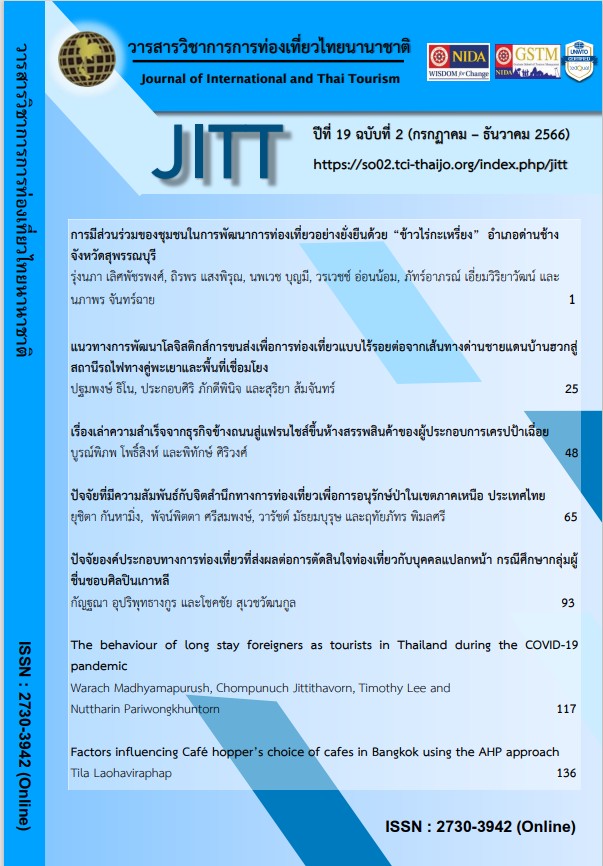The behaviour of long stay foreigners as tourists in Thailand during the COVID-19 pandemic The behaviour of long stay foreigners as tourists in Thailand during the COVID-19 pandemic
Main Article Content
บทคัดย่อ
This study looks at (1) the travel behaviour of long-term foreigners living in Thailand, and (2) investigates the influence of demographic factors on foreigners’ travel behavior in Thailand. It is quantitative research using a self-administrated and online questionnaire survey of 560 long-stay foreigners in Thailand. Both descriptive and inferential statistics are used to analyze the data. The results are that most respondents in this study have lived in Thailand for more than six years for work purposes. They rent a condominium or serviced apartment. The family members are two-three persons. And they travel once in every four to six months
for relaxation and sightseeing. Hypothesis testing shows that these demographic factors have aninfluence on travel behaviour. As a result, tourism authorities and businesses can adopt the results from this study for their marketing plans to help stimulate the tourism activity of foreigners living in Thailand.
Article Details

อนุญาตภายใต้เงื่อนไข Creative Commons Attribution-NonCommercial-NoDerivatives 4.0 International License.
เอกสารอ้างอิง
Abiad, A., Arao, M., Dagli, S., Ferrarini, B., Noy, I., Osewe, P., Platitas, R. (2020). The Economic Impact of the COVID-19 Outbreak on Developing Asia. Japan: Asian Development Bank.
Asunee Na Ayudhaya, N. (2019). The impact of COVID-19 in tourism to Thailand: A study of impact from Thailand's travel policies and regulations to its tourism sector. Bangkok: Thammasart University.
Axhausen, K. W. (2007, January). Concepts of Travel Behavior Research. Retrieved July 15, 2022, from https://www.researchgate.net/publication/237262766_Concepts_of_Travel_Behavior_Research.
Choe, Y., Wang, J., & Song, H. (2021). The impact of the Middle East Respiratory Syndrome coronavirus on inbound tourism in South Korea toward sustainable tourism. Journal of Sustainable Tourism, 29(7), 1117-1133.
Choibamroong, T. (2006, January-June). Knowledge of Tourists' Behavior: A Key Success Factor for Managers in Tourism Business. Retrieved July 17, 2022, from https://www.bu.ac.th/knowledgecenter/epaper/jan_june2006/Teardchai.pdf.
Gossling, S., Scott, D., & Hall, C. M. (2021). Pandemics, tourism and global change: A rapid assessment of COVID-19. Journal of Sustainable Tourism, 29(1), 1-20.
Intararat, K., Pankhao, O., Thongprayoon, C., Khachenpan, P., Eiummiran, T., Lomchawakarn, P., . . . Choonwijittra, W. (2006). Potential of Thialand in the Operation of Longstay Tourism (In Thai). Nontaburi: Sukhothai Thammathirat Open University .
Jittithavorn, C. (2007). Thailand and Leisure Oriented Cross-border Mobility: Constraints and Permeability. Dunedin, New Zealand: University of Otago.
Karantinou, K. M., Hogg, M. K., & Lewis, B. R. (2006). Cnaging perspectives on consumer behaviour. Journal of Consumer Behavior, 5(2), 97-101.
Kummaraka, K., & Jutaporn, R. (2011). The Motivation of Long-stay Tourism and International REtirement Migration: Swedish retirees in Thailand. Sweden: MALARDALENS HOGSKOLA ESKILSTUNA VASTERAS.
Madhyamapurush, W. (2022, January-June). Post Covid-19 Travel Behaviour of Thai Tourists in the Northern Region of Thailand. Journal of Sustainable Development, 4(1), 17-31.
Ministry of Tourism and Sports. (2020, September 23). Guidelines for exposure to special types of tourists with Special Tourist Visa (STV). Retrieved July 15, 2022, from https://thailand-longstay.com/wp-content/uploads/2020/09/Thailandlongstay01.pdf.
Ono, M. (2008). Long-stay Tourism and International Retirement Migration: Japanese Retirees in Malaysia. Transitional Migration in East Asia Senri Ethnological Reports, 77, 151-162.
Pongpirul, W., Pongpirul, K., Ratnarathon, A., & Prasithsirikul, W. (2020). Journey of a Thai Taxi Driver and Novel Coronavirus. New England Journal of Medicine, 382(11), 1067-1068.
Poon, A. (1993). Tourism, Technology, and Competitive Strategies. Wellingford, Oxon: CAB International.
Qiu, R. T., Park, J., Li, S., & Haiyan, S. (2020, September). Social costs of tourism during the COVID-19 pandemic. Annals of Tourism Research, 84, https://doi.org/10.1016/j.annals.2020.102994.
Richard, R., van der Pligt, J., & de Vries, N. (1996). Anticipated Affect and Behavioral Choice. Basic and Applied Social Psychology, 18(2), 111-129.
Rungsattra, C., Trakansiriwanich, K., Thongma, W., & Waiarpha, Y. (2021, January-April). Models of Long Stay Tourism for Korean Tourists Visiting Thailand. Dusit Thani College Journal, 15(1), 49-65.
Schiffman, L. G., & Kanuk, L. L. (2009). Consumer Behavior. Pearson.
TAT Newsroom. (2020a, February 13). Thailand's tourism events and activities go on as usual. Retrieved July 16, 2022, from https://www.tatnews.org/2020/01/thailands-tourism-events-and- activities-go-on-as-usual/.
TAT Newsroom. (2020b, February 25). Thailand declares COVID-19 a dangerous contagious disease: what it means to tourists? Retrieved July 16, 2022, from https://www.tatnews.org/2020/02/thailand-declares-covid-19-a- dangerous-contagious-disease-what-it-means-to-tourists/.
United Nations World Tourism Organization (UNWTO). (2020). UNWTO World Tourism Barometer May 2020 - Special focus on the Impact of COVID-19 (Summary). Madrid: World Tourism Organization.
Xue, L., & Zhang, Y. (2020, May). The effect of distance on tourist behavior: A study based on social media data. Annals of Tourism, 82, 12.
Yu, J., Park, J., & Hyun, S. S. (2021). Impacts of the COVID-19 pandemic on employees’ work stress, well-being, mental health, organizational citizenship behavior, and employee-customer identification. Journal of Hospitality Marketing & Management, 30(5), 529-548.


